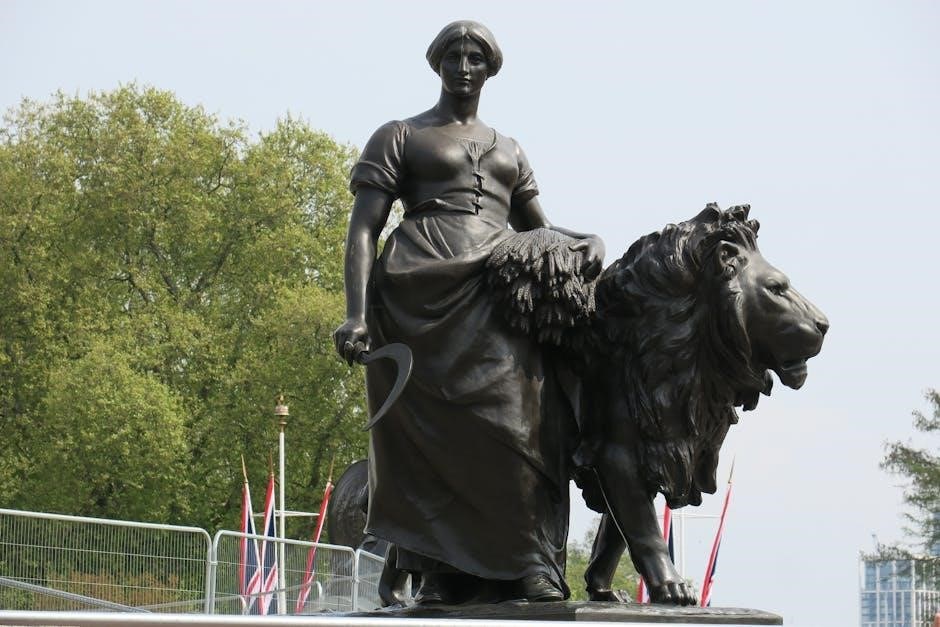
This timeless fantasy novel by C.S. Lewis introduces readers to Narnia, a magical land where a wardrobe serves as a portal to adventure and epic struggle.
Overview of the Book
The Lion, the Witch, and the Wardrobe, written by C.S. Lewis, is a captivating tale of four siblings—Peter, Susan, Edmund, and Lucy—who stumble upon a magical land called Narnia through an enchanted wardrobe. This land, ruled by the oppressive White Witch, is trapped in eternal winter without Christmas. The story unfolds as the Pevensie children become entangled in a prophecy foretelling their role in ending the Witch’s reign. With the guidance of the noble lion Aslan, who embodies sacrifice and redemption, the children navigate a world of talking beasts, ancient magic, and a climactic battle between good and evil. The novel is a cornerstone of The Chronicles of Narnia series, blending fantasy, adventure, and profound moral themes that resonate across generations. Its rich narrative and timeless lessons have made it a beloved classic in children’s and fantasy literature.
Significance in “The Chronicles of Narnia” Series
The Lion, the Witch, and the Wardrobe holds a pivotal place in The Chronicles of Narnia, serving as the series’ most iconic and widely read installment. It introduces key themes of sacrifice, redemption, and the struggle between good and evil, which resonate throughout the seven-book series. The story sets the foundation for Narnia’s lore, showcasing its magical creatures, historical prophecies, and the recurring motif of four human rulers. As the first published book, it captivated audiences with its vivid imagery and moral depth, establishing Narnia as a timeless realm in fantasy literature. Its influence extends beyond the series, shaping the genre and inspiring countless adaptations, ensuring its enduring relevance in popular culture and literary studies. This book remains a gateway to the enchanting world of Narnia for readers of all ages.

Author and Background
C.S. Lewis, a renowned scholar and theologian, crafted The Lion, the Witch, and the Wardrobe with inspirations from mythology, Christianity, and personal experiences, creating a timeless fantasy.
C.S. Lewis and His Inspiration
C.S. Lewis drew inspiration from Norse and Greek mythologies, as well as Christian theology, to create The Lion, the Witch, and the Wardrobe. His childhood imagination and personal faith significantly shaped Narnia’s magical world. Influenced by fairy tales, Lewis crafted a story blending moral lessons with fantastical elements. The character of Aslan, symbolizing sacrifice and redemption, reflects his deep Christian beliefs. Lewis’s experiences during World War II also influenced themes of hope and resistance against tyranny. The blend of mythology, personal faith, and imaginative storytelling resulted in a timeless narrative that continues to captivate readers across generations.
Historical Context of the Book’s Creation
The Lion, the Witch, and the Wardrobe was written during World War II, a time of global turmoil and uncertainty. C.S. Lewis, a professor at Oxford University, drew inspiration from the war’s themes of sacrifice, hope, and resistance against tyranny. The story reflects the moral clarity of the era, with the White Witch symbolizing oppressive regimes like Nazi Germany. Lewis also crafted the narrative during a period of personal reflection, blending his Christian faith with mythological elements. The post-war era’s longing for escapism and moral guidance further shaped the book’s appeal. Published in 1950, it resonated with a world rebuilding itself, offering timeless lessons about courage, sacrifice, and redemption.

Plot Summary
The story follows the Pevensie siblings as they discover Narnia, a land under the White Witch’s icy rule. With Aslan’s guidance, they join forces to end her reign.
The Discovery of Narnia
During World War II, the Pevensie children—Peter, Susan, Edmund, and Lucy—are evacuated to the countryside. While exploring the large, old house of Professor Kirke, Lucy stumbles upon a mysterious wardrobe. Curiosity leads her to step inside, where she finds herself in the enchanted land of Narnia. The wardrobe serves as a magical portal, transforming her surroundings from a dimly lit room to a snow-covered forest. Here, she encounters the talking faun Mr. Tumnus, who introduces her to the true nature of Narnia, a land frozen in eternal winter by the White Witch. Lucy’s discovery sets the stage for her siblings’ eventual entrance into Narnia, marking the beginning of their extraordinary adventure.
The Role of the White Witch
The White Witch, also known as Jadis, is the primary antagonist who rules Narnia with an iron fist, casting a spell that enforces eternal winter without Christmas. Her reign is marked by fear and tyranny, as she uses her magical powers to maintain control and eliminate any threats to her dominance. The White Witch is driven by a deep-seated desire for power and a prophetic fear of her eventual overthrow by human rulers. Through enchantments and manipulation, she maintains her grip on Narnia, turning her enemies to stone and discouraging dissent. Her encounter with Edmund Pevensie showcases her cunning, as she exploits his vulnerabilities to further her own agenda and prevent the fulfillment of the prophecy that threatens her rule.
The Lion Aslan and His Destiny
Aslan, the majestic lion, embodies wisdom, courage, and divine authority in Narnia. His destiny is intertwined with the battle between good and evil, as he leads the fight against the White Witch. Aslan’s role is not only to protect Narnia but also to fulfill the prophecies tied to the Deep Magic, which foretell his ultimate victory. His sacrifice and resurrection symbolize redemption, making him the cornerstone of Narnia’s salvation. Aslan’s guidance and strength inspire the Pevensie children and other allies, uniting them against darkness. His destiny is fulfilled as he restores peace to Narnia, solidifying his legacy as a symbol of hope and justice.

Main Characters
The story centers around the Pevensie siblings—Peter, Susan, Edmund, and Lucy—who discover Narnia through a magical wardrobe. Aslan, the wise lion, and the White Witch are central figures.
The Pevensie Children: Peter, Susan, Edmund, and Lucy
The Pevensie siblings—Peter, Susan, Edmund, and Lucy—are central to the narrative. Each child represents distinct traits and undergoes significant development throughout their journey in Narnia.
The White Witch: Her Powers and Motivations
The White Witch, also known as Jadis, is a powerful sorceress who rules Narnia with an iron fist. Her magic allows her to petrify her enemies, turning them into stone statues. She maintains control through fear and deception, ensuring Narnia remains in perpetual winter without Christmas. Motivated by a desire for absolute power, she seeks to prevent a prophecy that foretells her downfall at the hands of four human siblings. Her charm and manipulative nature are evident in her interactions, particularly with Edmund, whom she lures with promises of power. Symbolizing pure evil, the White Witch embodies tyranny and oppression, contrasting sharply with the redemption offered by Aslan. Her reign of terror drives the central conflict of the story, making her one of literature’s most iconic villains.
Aslan: The Lion as a Symbol of Sacrifice and Redemption
Aslan, the majestic lion, is the embodiment of sacrifice and redemption in “The Lion, the Witch, and the Wardrobe.” His divine wisdom, kindness, and unwavering courage make him a central figure in Narnia’s destiny. Aslan’s willingness to sacrifice his life to save Edmund, a traitorous sibling, underscores his selfless nature. His death and subsequent resurrection symbolize the triumph of good over evil, mirroring themes of forgiveness and renewal. Through his actions, Aslan inspires hope and transformation in the characters, particularly the Pevensie children, guiding them toward their destinies. His sacrifice not only redeems Edmund but also restores peace to Narnia, solidifying his role as a symbol of divine love and redemption.

Themes and Symbolism
The story explores themes of courage, sacrifice, and redemption, with the wardrobe symbolizing a gateway to transformation and the battle between good and evil.
Good vs. Evil: The Central Conflict
The struggle between good and evil is the heart of the narrative, with Aslan representing righteousness and the White Witch embodying tyranny. Their clash shapes Narnia’s fate, symbolizing universal moral battles. The Witch’s rule of fear and oppression contrasts with Aslan’s leadership of courage and sacrifice, highlighting the eternal conflict between light and darkness. This duality not only drives the plot but also mirrors real-world ethical dilemmas, making the story profoundly relatable. Through this lens, Lewis explores the nature of morality, encouraging readers to reflect on their own choices and the broader implications of good and evil in society.
Sacrifice and Redemption in the Story
The narrative profoundly explores themes of sacrifice and redemption, with Aslan’s selfless death serving as the pinnacle of these motifs. His willingness to surrender his life to save Edmund underscores the depth of his compassion and commitment to justice. This act, followed by his resurrection, symbolizes the triumph of good over evil and the promise of redemption. Similarly, Edmund’s journey from betrayal to loyalty exemplifies personal redemption, as he seeks forgiveness and proves himself in battle. Through these elements, Lewis conveys the transformative power of sacrifice and the possibility of redemption, even in the face of great wrongdoing. These themes resonate deeply, offering hope and moral guidance to readers.
The Wardrobe as a Symbol of Transition
The wardrobe in The Lion, the Witch, and the Wardrobe serves as a potent symbol of transition, bridging the ordinary world of 1940s England and the magical realm of Narnia. It represents a gateway to adventure, transformation, and the unknown, inviting characters and readers alike to step into a realm beyond their imagination. For Lucy, the wardrobe is her first encounter with Narnia, marking the beginning of her journey from innocence to understanding. Similarly, for the Pevensie siblings, it symbolizes their collective transition from childhood naivety to the responsibilities of heroism. The wardrobe’s dual role as a literal and metaphorical threshold underscores the story’s themes of growth and the passage into a broader world of possibilities and challenges.

Moral and Ethical Questions
The story explores moral dilemmas, such as Edmund’s betrayal and the consequences of selfish choices, prompting reflections on guilt, forgiveness, and the nature of right and wrong.
Edmund’s Betrayal and Redemption
Edmund’s betrayal of his siblings to the White Witch, driven by his desire for power and Turkish Delight, marks a pivotal moral conflict in the story. His actions lead to severe consequences, threatening Narnia’s fate. However, through Aslan’s guidance, Edmund confronts his guilt and ultimately redeems himself by joining the battle against evil. This journey illustrates the struggle between selfishness and loyalty, highlighting the possibility of forgiveness and personal growth. Edmund’s redemption serves as a powerful lesson in the importance of accountability and the transformative power of courage and sacrifice.
The Concept of Forgiveness in Narnia
Forgiveness is a central theme in The Lion, the Witch, and the Wardrobe, as it underscores the transformative power of mercy and compassion. The White Witch, embodying tyranny and vengeance, refuses to forgive, creating a realm of fear and oppression. In contrast, Aslan’s unconditional forgiveness, particularly toward Edmund, highlights the redemptive nature of grace. This act of forgiveness not only restores Edmund but also strengthens the bonds of unity among the Pevensie siblings and the people of Narnia. The story illustrates that true healing and reconciliation can only occur through the willingness to forgive, even in the face of betrayal and wrongdoing.

Religious Allegory
C.S. Lewis weaves profound Christian symbolism, with Aslan representing Christ, offering sacrificial redemption. The White Witch symbolizes sin, and Narnia’s resurrection mirrors divine salvation through faith.

Christian Themes in the Narrative
The narrative of The Lion, the Witch, and the Wardrobe is deeply infused with Christian themes. Aslan, the lion, symbolizes Jesus Christ, embodying sacrifice and redemption. His death at the hands of the White Witch and subsequent resurrection mirror the crucifixion and resurrection of Christ, serving as a powerful allegory for divine sacrifice. The struggle between good and evil reflects the biblical conflict between God and Satan, with Aslan leading the forces of good to triumph over darkness. Through these elements, C.S. Lewis conveys timeless moral and spiritual truths, making the story a compelling exploration of faith and salvation. The White Witch, with her icy grip on Narnia, represents sin and tyranny, while Aslan’s sacrifice and victory symbolize forgiveness and eternal life.
Aslan’s Sacrifice and Resurrection
Aslan’s sacrifice and resurrection are central to the narrative, symbolizing redemption and divine love. He willingly surrenders to the White Witch to save Edmund, mirroring Christ’s crucifixion for humanity’s sins. His death, followed by a miraculous resurrection, represents the triumph of good over evil and the promise of eternal life. This act of selfless sacrifice underscores the theme of redemption, as Aslan’s death atones for Edmund’s betrayal. The resurrection reaffirms hope and the ultimate victory of justice, aligning with Christian theology. Through Aslan’s journey, C.S. Lewis conveys profound spiritual truths, making the story a timeless allegory of sacrifice, forgiveness, and renewal. This pivotal moment in the story remains a cornerstone of its enduring moral and ethical resonance.

Adaptations and Interpretations
“The Lion, the Witch, and the Wardrobe” has been adapted into films, TV series, and stage plays, each offering unique interpretations while staying true to the original story.
The 2005 Film Adaptation
The 2005 film adaptation of The Lion, the Witch, and the Wardrobe, directed by Andrew Adamson, brought C.S. Lewis’s beloved story to life with stunning visual effects and a faithful adaptation of the original narrative. Produced by Walden Media and 20th Century Fox, the movie captured the magical essence of Narnia, featuring an all-star cast, including Tilda Swinton as the White Witch and Liam Neeson as the voice of Aslan. The film remained true to the book’s themes of courage, sacrifice, and redemption while introducing the story to a new generation of audiences. Its success at the box office and critical acclaim solidified its place as a modern classic, paving the way for further adaptations in the Chronicles of Narnia series.
Stage Play and Other Adaptations
The Lion, the Witch, and the Wardrobe has been adapted into numerous stage productions, with one of the most notable being the theatrical version that premiered in London’s West End; The play captures the essence of the novel, blending drama, music, and elaborate costumes to bring Narnia to life. Additionally, the story has been adapted into radio plays, audiobooks, and even graphic novels, ensuring its accessibility to diverse audiences. A 1988 BBC miniseries also showcased the tale, offering a faithful rendition of the book’s magic. These adaptations highlight the enduring appeal of C.S. Lewis’s narrative, allowing generations to experience the battle between good and evil in Narnia through various mediums.

Cultural Impact
The Lion, the Witch, and the Wardrobe has left an enduring influence on fantasy literature and popular culture, inspiring countless adaptations and shaping modern storytelling.
Reception and Popularity of the Book
The Lion, the Witch, and the Wardrobe has captivated readers for decades, becoming a beloved classic in fantasy literature. Its universal themes of courage, sacrifice, and redemption resonate across generations. The book’s vivid storytelling and memorable characters, such as Aslan and the White Witch, have endeared it to audiences worldwide. Critics praise its rich symbolism and moral depth, while readers appreciate its ability to appeal to both children and adults. The novel’s popularity has been further amplified by its adaptation into films, plays, and other media, ensuring its timeless appeal. Today, it remains a cornerstone of fantasy literature, inspiring new adaptations and captivating readers with its enchanting world of Narnia.
Influence on Fantasy Literature and Film
The Lion, the Witch, and the Wardrobe has profoundly shaped the fantasy genre, inspiring countless authors and filmmakers. Its richly imagined world of Narnia, complete with magical creatures and epic battles between good and evil, has set a benchmark for fantasy storytelling. The book’s exploration of universal themes such as sacrifice, redemption, and the struggle between light and darkness has influenced works like J;K. Rowling’s Harry Potter series and George R.R. Martin’s A Song of Ice and Fire. In film, the 2005 adaptation showcased groundbreaking visual effects and brought Narnia to life for a new generation, influencing the production of other fantasy movies with its innovative use of CGI and immersive world-building. The story’s enduring popularity continues to inspire new adaptations and reinterpretations, ensuring its legacy in both literature and cinema.
The Lion, the Witch, and the Wardrobe remains a timeless tale of sacrifice, redemption, and the eternal struggle between good and evil, resonating across generations.
Legacy of “The Lion, the Witch, and the Wardrobe”
Published in 1950, this novel has become a cornerstone of fantasy literature, inspiring countless adaptations and influencing authors worldwide. Its enduring themes of courage, sacrifice, and redemption continue to captivate readers of all ages. The story’s rich symbolism and moral depth have solidified its place as a classic, ensuring its relevance for future generations. The book’s impact extends beyond literature, shaping popular culture through films, stage plays, and other media. Aslan’s journey remains a powerful allegory, resonating deeply with audiences seeking hope and inspiration. The legacy of Narnia endures, proving that timeless stories can transcend time and culture, offering universal truths and timeless wisdom.
Why the Story Remains Relevant Today
The story’s exploration of universal themes such as courage, betrayal, forgiveness, and sacrifice continues to resonate with modern audiences. Its depiction of a battle between good and evil offers timeless moral lessons, applicable across cultures and generations. The relatable struggles of the Pevensie children, navigating adolescence and responsibility, make the narrative accessible to readers today. The fantasy world of Narnia serves as a metaphor for real-world challenges, encouraging reflection on personal values and ethics. Additionally, the story’s emphasis on hope and redemption provides comfort in uncertain times, ensuring its relevance in contemporary society. The enduring appeal of “The Lion, the Witch, and the Wardrobe” lies in its ability to transcend time, offering insights into the human condition that remain as pertinent now as they were at its publication.









